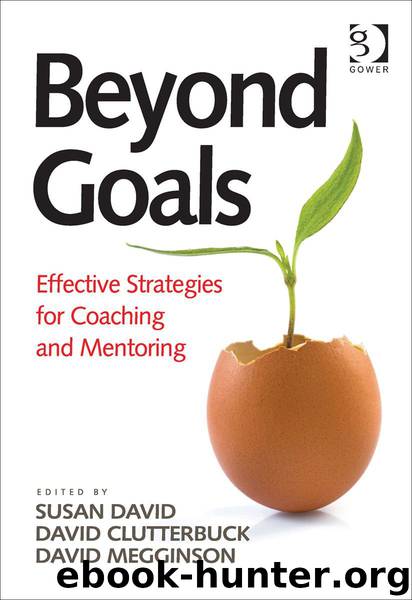Beyond Goals: Effective Strategies for Coaching and Mentoring by Susan David & David Clutterbuck & David Megginson

Author:Susan David & David Clutterbuck & David Megginson
Language: eng
Format: mobi
Publisher: Ashgate Publishing Ltd
Published: 2013-09-01T14:00:00+00:00
Is only a shell, a husk of meaning
From which the purpose breaks only when it is fulfilled
If at all. Either you had no purpose
Or the purpose is beyond the end you figured
And is altered in fulfilment.
Chaotic systems are a type of complex system. More accurately, chaos is a phase that complex systems often go through. Contrary to the common understanding of the term chaos, chaotic systems are not without order. Rather, complex systems become chaotic when the behavior of the system’s agents becomes independent rather than interdependent (Pina e Cunha and Rego, 2010).
While players on a football field form a complex system, a pitch invasion would be a chaotic system. The immediate reaction of nations and institutions to the failure of the subprime market would be an example of chaotic phase space.
The role of leadership and coaching in such spaces is to assist the stakeholders in the system to move back toward the complex space—to build perspectives and structures that enable the re-emergence of interdependent action (Cavanagh and Lane, 2012). Here the identification of perspectives that enable stakeholders to reconnect with the system in interdependent action is important. Coercive strategies that seek to impose simple or bureaucratic solutions in an attempt to escape the tension distress of chaos are likely to lead to lower levels of adaptability in the system over time. The search for simple solutions in chaotic times is not surprising. In times of distress we begin to draw stronger and narrower boundaries around ourselves and our thought action repertoires become restricted (Fredrickson, 2001). We narrow the horizon of our thinking when what is needed is bigger systemic perspective.
A WIDER SYSTEMIC HORIZON WITH MORE INCLUSIVE SYSTEM BOUNDARIES
The challenges the world is facing require us to extend the boundaries of the system we typically consider. The interconnectedness of the modern world means that what happens at any level of the system has impacts at all other levels. Companies can no longer be seen independently of the industries, societies and environments in which they are situated, and individuals and teams can no longer be thought of as productive units or resources to be utilized by the organization.
The size and interconnectedness of our systems also means that we can no longer treat impacts or costs, borne elsewhere in the system, or by future generations, as externalities. These need to be internalized (Goodwin, 2007). Cradle to grave accounting (or product life accounting), the introduction of triple bottom line reporting, and carbon trading schemes are all early indicators of a shift in the systemic horizon.
In conventional organizational models, extra-systemic impacts are typically seen as the domain of management. It is the leader’s role to look outward, predict and deal with the wider system (Obolensky, 2010). However, in the emerging paradigm, leadership is an emergent property distributed across the whole system. The matrixed nature of our system connections also means that impacts are likely to show up at levels of the system in which leaders have little visibility. For example, finance staff may be
Download
This site does not store any files on its server. We only index and link to content provided by other sites. Please contact the content providers to delete copyright contents if any and email us, we'll remove relevant links or contents immediately.
The Brazilian Economy since the Great Financial Crisis of 20072008 by Philip Arestis Carolina Troncoso Baltar & Daniela Magalhães Prates(106835)
International Integration of the Brazilian Economy by Elias C. Grivoyannis(76561)
The Art of Coaching by Elena Aguilar(52249)
Flexible Working by Dale Gemma;(23213)
How to Stop Living Paycheck to Paycheck by Avery Breyer(19574)
The Acquirer's Multiple: How the Billionaire Contrarians of Deep Value Beat the Market by Tobias Carlisle(12120)
Thinking, Fast and Slow by Kahneman Daniel(11837)
The Radium Girls by Kate Moore(11652)
The Art of Thinking Clearly by Rolf Dobelli(9951)
Hit Refresh by Satya Nadella(8878)
The Compound Effect by Darren Hardy(8544)
Atomic Habits: Tiny Changes, Remarkable Results by James Clear(8067)
Tools of Titans by Timothy Ferriss(7850)
Turbulence by E. J. Noyes(7733)
Change Your Questions, Change Your Life by Marilee Adams(7405)
A Court of Wings and Ruin by Sarah J. Maas(7307)
Nudge - Improving Decisions about Health, Wealth, and Happiness by Thaler Sunstein(7273)
How to Be a Bawse: A Guide to Conquering Life by Lilly Singh(7175)
Win Bigly by Scott Adams(6846)
